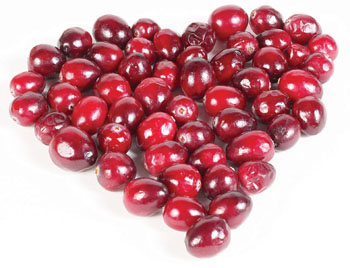![[Metroactive Dining]](/dining/gifs/dining468.gif)
[ Dining Index | Santa Cruz Week | SantaCruz Home | Archives ]
Cran Prix
A Thanksgiving staple has sunk into a canned, pseudofood existence. Cranberry, what has become of you?
By Steve Billings
No other meal seems to have as many sides and trimmings, traditions and trappings as the Thanksgiving feast. The gravy, the mashed potatoes, the stuffing, the rolls, the cranberry (we'll get to that); aside from the turkey there are countless side dishes one could prepare, some of which are heavily invested with familial history. There are so many, it's difficult to determine which are necessary, and which are vestigial appendages.
The meal also conjures strange behaviors from participants. People without normally detectable culinary pretensions or cares at other times of year seem to do their best to exercise them especially for this day, insisting on certain time-tested methods experienced in their youth and, in the process, ruining your rhythm in the kitchen with misguided assistance and dumb comments.
Those who do possess them exhibit the opposite behavior and seem to revert to more philistine times, insisting you make the yams with marshmallows on top because that's how they're made, even if they suck, and you know they just miss home and are being disgustingly nostalgic.
My mother always did this mother of meals right and, ostensibly, by herself. That meant prep time in the days leading up to Thursday and a pre-sunrise appointment in the kitchen to have things ready by 1 or 2pm on Thanksgiving day while we lazy people drank mimosa and watched football. This is a gargantuan effort to get people fed, and if you do it by yourself you are a hero and deserve to be called one.
Personally, I don't want that much work for the amount of time spent at the table. I want people to step up and contribute to the feast especially so things like the cranberry sauce don't get overlooked by an overworked cook looking for few shortcuts to make the load bearable.
You Call That Cranberry?
Almost everybody I know includes cranberry sauce on their table at Thanksgiving time without a thought. The tangy, citrusy fruit provides a good counterbalance to the savory herbs and richness of the turkey. Sadly, most store-bought iterations more closely resemble the gelatinous dumps released from tinned dog food than they do the produce of one of the only three native North American berries (blueberries and Concord grapes being the other two).
Though olfactorily less offensive than canine cuisine, canned cranberry is a jellied cylinder of frightening consistency. Replete with signature tin-can ribs, it slides from its home in a perfect mold, a crimson monolith waiting to be sliced into servitude.
It wasn't always this way. Though the first commercial cranberry sauce came on the market in 1912, the berry's relationship with humans begins with the Native American tribes of eastern North America, who used the wild-growing fruit in a multitude of ways. As a foodstuff, crushed cranberries were pounded together with game meat (mostly deer), fat and grains into a winter survival or journey ration known as pemmican. Medicinally, cranberries were applied as poultices to arrow wounds and used as a fabric dye for rugs and weavings. Native Americans introduced cranberries to early settlers who soon began using them with other staples like salt cod and cornmeal. The fruit also became a popular addition to whaling vessels for its significant quantities of vitamin C.
Ironically cranberries were given their current moniker not by Native Americans (who variously referred to the berry as sassamanesh, ibimi and atoqua) or Pilgrims, but by German and Dutch settlers who thought that the vine's blossoms resembled the neck, head and bill of a crane. Cranes were also seen frequently dining on the abundant berries, further cementing the association. Over time, the "e" was dropped, and craneberries became cranberries.
My hope is that instead of opening a can of cran this year, people will choose to buy fresh ones and prepare them minimally.
Think about creating a sauce that is more along the lines of a chutney or relish and contains citrus fruits like oranges and lemons or maybe even some chopped nuts. You could grind the cranberries (2 pounds) in a meat grinder or pulse them in a food processor along with both a peeled orange and lemon and including some of the zest and peels of the two fruits. Sweeten them with to your taste with sugar (it may take a bit) and maybe even Gran Marnier.
Prepare this the day before and you'll thank yourself. The flavors need time to marry and soak up the liquor. Most likely, you will too.
Copyright © Metro Publishing Inc. Maintained by Boulevards New Media.
For more information about Santa Cruz, visit santacruz.com.
![]()

The Real Thing: You can't get true cranberry taste from a can.
From the November 24-December 1, 2004 issue of Metro Santa Cruz.